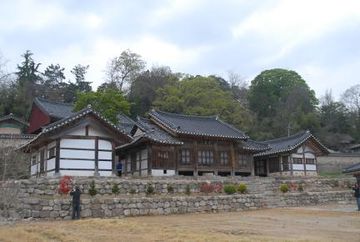김제군 관아와 향교
| 김제군 관아와 향교 Gimje-gun Government Office and Local Confucian School |
|
 김제군 관아와 향교, 국가문화유산포털, 문화재청. |
|
| 대표명칭 | 김제군 관아와 향교 |
|---|---|
| 영문명칭 | Gimje-gun Government Office and Local Confucian School |
| 한자 | 金堤郡 官衙와 鄕校 |
| 주소 | 전북 김제시 교동 7-3번지(관아 - 35.800861, 126.881995) / 전북 김제시 향교길 89-3(향교 - 35.800535, 126.879417) |
| 지정(등록) 종목 | 사적 제482호 |
| 지정(등록)일 | 2007년 7월 31일 |
| 분류 | 유적건조물 |
| 시대 | 조선시대 |
| 수량/면적 | 15,685㎡ |
| 웹사이트 | 김제군 관아와 향교, 국가문화유산포털, 문화재청. |
해설문
국문
김제군 관아와 향교는 지방 통치 기능을 담당하였던 관아와 교육 가능을 담당하였던 향교를 아울러 이르는 말로 서로 인접한 거리에 있다.
김제군 관아는 현종 8년(1667)에 군수 민도가 세웠다고 한다. 동헌의 이름은 근민헌이라고 했으나 숙종 25년(1699)에 중수하면서 사칠헌*으로 바꿨다. 현재의 동헌은 고종 18년(1881)에 중건한 것이며, 1960년대 초까지 읍사무소로 사용하였고, 1984년에 복원하였다. 현재는 수령의 집무 공간인 동헌과 개인적으로 생활하는 공간인 내아, 누정인 피금각과 관리사가 남아 있다.
향교는 지역 유생들의 교육과 유교 성현에 대한 제사 기능을 담당하던 곳이다. 김제향교는 태종 4년(1404)에 처음 지어졌으나 정유재란 때 불에 탔고, 인조 13년(1635)에 다시 세운 후 몇 차례 고쳐 지었다고 한다. 외삼문인 만화루, 교육 공간인 명륜당, 유생들의 기숙사인 동재와 서재, 그리고 제향 공간인 대성전과 동무, 서무로 구성되어 있다. 특이한 점은 명륜당 바로 옆에 동재와 서재가 자리하고 있다는 점이다.
김제군 관아와 향교는 조선 시대 행정 기관과 교육 기관을 연구하는데 중요한 자료이며, 이 동헌은 내아가 함께 남아 있는 관아 건축물로써 학술적 연구에 중요한 자료이다.
- 사칠헌(事七軒): 7가지 공무(호적, 농사, 병무, 교육, 세금, 재판, 풍속)를 맡아보는 관아라는 뜻
영문
Gimje-gun Government Office and Local Confucian School
This local government office and local Confucian school, located next door to each other, were established during the Joseon period (1392-1910).
The local government office consists of the magistrate’s office, his residence, a pavilion, and a custodian's office. It is very rare to see a magistrate’s office remaining together with the residence. The magistrate’s office is presumed to have been established around the mid-16th century, and the current building was constructed in 1881. It had been used as a local government office up to the early 1960s. The magistrate’s residence is located right behind the magistrate’s office. While only one residential building remains today, it is said there used to be several more buildings in the residence. The pavilion standing next to the magistrate’s office was built in 1633 as a leisure space.
Local Confucian schools, called hyanggyo in Korean, are public education institutions of the Goryeo (918-1392) and Joseon periods. They were established nationwide to function as local shrines for Confucius and other sages and to promote Confucian education and nurture elites in local districts. Students learned about literature including poetry composition, Confucian Classics, and history.
Gimjehyanggyo Local Confucian School was established in 1404. It was burnt down during the Japanese invasion of 1597-1598, reconstructed in 1635, and repaired several times after then. The school consists of a gate quarters, a lecture hall called Myeongnyundang, two dormitories, an inner gate, two auxiliary shrines, and a main shrine called Daeseongjeon. The main shrine enshrines spirit tablets of 27 Confucian sages including Confucius, and rituals are performed for them biannually in spring and fall.
Because this village was home to the area's local Confucian school, it came to be known as Gyo-dong, meaning "school village."
- 김제군 관아에 포함된 건물 중 ‘관리사’가 무엇인지... 사진 자료에는 없던데 현재 운영되는 관리사무소일까요?? --> a custodian's office
영문 해설 내용
이곳에는 조선시대 지방 관청인 관아와 교육기관인 향교가 서로 매우 인접한 거리에 위치해 있다.
김제군 관아에는 수령의 집무공간인 동헌, 생활공간인 내아, 누정, 관리사가 있다. 동헌과 내아가 함께 남아있는 매우 드문 사례이다. 동헌은 16세기 중반에 세워진 것으로 추정되며, 현재의 건물은 1881년에 고쳐 지은 것이다. 1960년대 초반까지는 읍사무소로 사용되었다. 내아는 동헌의 바로 뒤편에 있으며, 지금은 안채만 남아있지만, 본래 여러 부속건물이 있었다고 한다. 동헌 옆에 있는 피금각은 1633년에 휴식을 위한 공간으로 지어졌다.
향교는 고려시대와 조선시대 지방에서 유학을 교육하기 위하여 설립된 국립교육기관이다. 덕행과 학문의 모범을 보인 성현에게 제사를 올리며, 유교의 경전과 역사, 시나 문장을 짓는 법을 가르쳤다.
김제향교는 1404년에 처음 지어졌으나 정유재란 때 불에 탔고, 1635년에 다시 세운 후 몇 차례 고쳐 지었다고 한다. 문루, 교육공간인 명륜당, 유생들의 기숙사인 동·서재, 내삼문, 동·서무, 사당인 대성전으로 구성되어 있다. 대성전에는 공자를 비롯한 유교 성현 27분의 위패가 모셔져 있고, 해마다 봄과 가을에 이들을 기리는 제사를 지낸다.
이 마을은 향교가 있던 곳이기 때문에 교동이라고 불리게 되었다.
참고 자료
- 정밀실측 조사보고서 - 김제군 관아와 향교 , 문화재청, 2012.
- 문화재청 http://www.heritage.go.kr/heri/cul/culSelectDetail.do?VdkVgwKey=13,04820000,35&pageNo=5_1_1_0
- https://blog.naver.com/jcjkks/70098664465